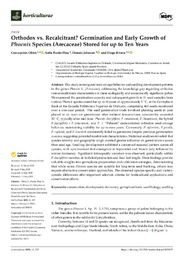Please use this identifier to cite or link to this item:
https://hdl.handle.net/11000/38287Full metadata record
| DC Field | Value | Language |
|---|---|---|
| dc.contributor.author | Obón, Concepción | - |
| dc.contributor.author | Pardo Pina, Sofía | - |
| dc.contributor.author | Johnson, Dennis | - |
| dc.contributor.author | Rivera, Diego | - |
| dc.contributor.other | Departamentos de la UMH::Biología Aplicada | es_ES |
| dc.date.accessioned | 2025-11-18T12:24:55Z | - |
| dc.date.available | 2025-11-18T12:24:55Z | - |
| dc.date.created | 2025 | - |
| dc.identifier.citation | Horticulturae 2025, 11, 537 | es_ES |
| dc.identifier.issn | 2311-7524 | - |
| dc.identifier.uri | https://hdl.handle.net/11000/38287 | - |
| dc.description.abstract | This study investigated seed storage behavior and seedling development patterns in the genus Phoenix L. (Arecaceae), addressing the knowledge gap regarding orthodox versus recalcitrant characteristics in these ecologically and economically significant palms. We examined the germination capacity and subsequent growth in 31 seed samples from various Phoenix species stored for up to 10 years at approximately 5 ◦C, at the Germplasm Bank at the Escuela Politécnica Superior de Orihuela, comprising 465 seeds monitored over a one-year period. The seed germination trials involved planting seeds in pots placed in an open-air greenhouse after ambient temperatures consistently exceeded 20 ◦C, typically after mid-June. Phoenix dactylifera, P. canariensis, P. theophrasti, the hybrid P. dactylifera × P. canariensis, and P. × “Palmeri” demonstrated orthodox seed storage behavior, maintaining viability for up to nine years. Conversely, P. sylvestris, P. pusilla, P. rupicola, and P. loureiroi consistently failed to germinate despite previous germination success, suggesting potential recalcitrant characteristics. Statistical analyses revealed that species identity and geographic origin exerted greater influence on germination success than seed age. Seedling development exhibited a conserved seasonal pattern across all species, with synchronized leaf emergence in September and March–July, followed by winter dormancy. Significant intraspecific variation was observed, particularly within P. dactylifera varieties, in both leaf production and final leaf length. These findings provide valuable insights into germplasm preservation and cultivation strategies, demonstrating that while some Phoenix species are suitable for long-term seed banking, others may require alternative conservation approaches. The observed species-specific and varietyspecific differences offer important selection criteria for horticultural applications and conservation efforts. | es_ES |
| dc.format | application/pdf | es_ES |
| dc.format.extent | 26 | es_ES |
| dc.language.iso | eng | es_ES |
| dc.publisher | MDPI | es_ES |
| dc.rights | info:eu-repo/semantics/openAccess | es_ES |
| dc.rights | Attribution-NonCommercial-NoDerivatives 4.0 Internacional | * |
| dc.rights.uri | http://creativecommons.org/licenses/by-nc-nd/4.0/ | * |
| dc.subject | conservation | es_ES |
| dc.subject | development | es_ES |
| dc.subject | dormancy | es_ES |
| dc.subject | germplasm bank; | es_ES |
| dc.subject | seed biology | es_ES |
| dc.subject | seedling | es_ES |
| dc.title | Orthodox vs. Recalcitrant? Germination and Early Growth of Phoenix Species (Arecaceae) Stored for up to Ten Years | es_ES |
| dc.type | info:eu-repo/semantics/article | es_ES |
| dc.relation.publisherversion | https://doi.org/10.3390/horticulturae11050537 | es_ES |

View/Open:
Ortodox horticulturae-11-00537r.pdf
889,25 kB
Adobe PDF
Share:
.png)
